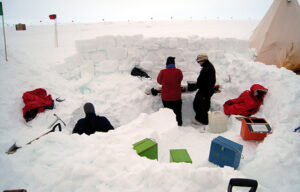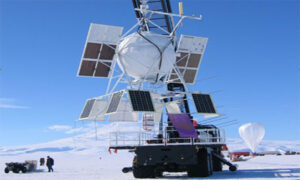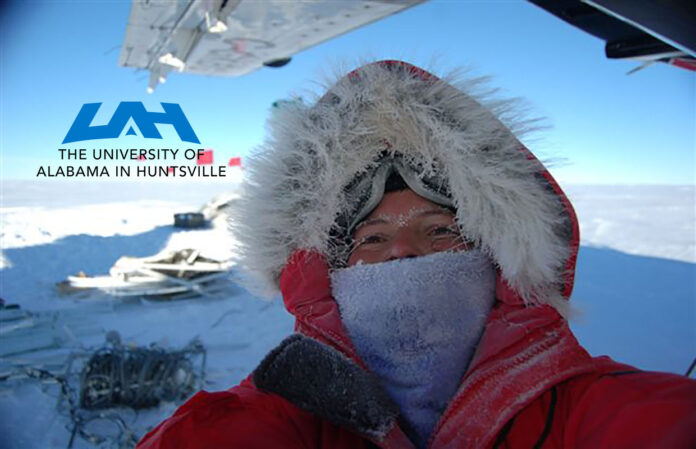HUNTSVILLE — In 2008, Tia Ferguson ventured to a place so remote and forbidding, even veteran world travelers can be daunted by the prospect of such a journey.
That was the year she trekked to the bottom of the world to help retrieve a NASA experimental package.
An alum of the University of Alabama in Huntsville, Ferguson spent four weeks in Antarctica assisting with the recovery of a science experiment dropped from a balloon near the South Pole.

(Courtesy NASA)
Her job as an engineer at the Marshall Space Flight Center gave her the opportunity to travel to the world’s most desolate terrain, a trip she had never imagined might be part of her job description in those days.
Around this time, Ferguson had been doing mechanical design for balloon, telescope, satellite, rocket and ground experiments.
“I’ve always been involved with scientists throughout my career,” Ferguson said. “I was in project management, and I wanted to go back into tech. Basically I did everything, the concept, the design, contracting the machine shop, the integration and testing, and even operating.
“Getting the gondola to launch, from cradle to grave.”
NASA asked Ferguson to help with the Antarctic recovery because she had had experience recovering a balloon science experiment, NASA’s Deep Space Test Bed, in New Mexico, a package she had designed in 2005.
“One of our payloads in New Mexico was a student initiative to build science experiments on our test flight, and UAH won one of those,” she said. “So I worked with UAH to develop an experiment that flew on the gondola. It was one of their senior design projects that year.”

experiment studied cosmic rays, a sample of matter from distant regions of Earth’s galaxy.
(Courtesy NASA)
The majority of Ferguson’s four weeks in Antarctica, from Jan. 4 to Feb. 5, 2008, was spent at McMurdo Station. McMurdo is a science research facility operated by the National Science Foundation. The station is on Ross Island just off Antarctica’s eastern coast. The faraway base held a number of surprises for Ferguson.
“It was more industrial than I expected,” Ferguson said. “The smell of diesel, no earthly smells, only machine smells. It was also warmer. The temperature hovered around the 30s and 40s Fahrenheit, while the temperature at the pole was much colder, close to minus-40 Fahrenheit with a wind chill factor of minus-80 Fahrenheit.”
Though she played no role in the design of the Antarctic package, Ferguson said she was excited to be on the recovery team. The balloon circled above the continent for about two weeks until the Advanced Thin Ionization Calorimeter experiment was released on a parachute. Attached to a large plastic balloon that floated above Earth’s southernmost continent, ATIC studied cosmic rays – particles traveling at nearly the speed of light.
Though bleak and unforgiving, Antarctica is a prime environment to fly high-altitude balloons. Its unique circular wind pattern that develops during the Antarctic summer causes balloons to circle the continent for several weeks. The balloons ascend to as high as 130,000 feet, approximately 23 miles. This allows the experiments to make observations about space matter in Earth’s atmosphere.
The altitude of the inner plateau Antarctica can be quite a challenge for newcomers.
“We took medicine for the altitude, and they gave us a week to acclimate before jumping into lifting and hauling,” Ferguson said. “The frozen water around your eyelashes was a real problem. At the end of the day, you had all this ice caked on like icicles and it made it hard to even blink.”
A native of Natchez, Miss., Ferguson is the director of the Space Systems Department, the kind of role she has seemingly been destined to fill since her earliest days at MSFC.
“We have about 600 government and contractor engineers who are focused really on all aspects of what NASA is doing involving space,” she said. “Our engineers wrote the software for SLS in-house, life support systems for ISS (International Space Station) and we are doing insight for human landing software and avionics. We just launched a telescope that studies high energy X-ray polarization of black holes and other interests in the galaxy.
“The telescope is commonly known as IXPE for Imaging X–ray Polarimetry Explorer. We are launching a solar sail on the SLS rocket that will travel to an asteroid, known as NEAScout. I’m in an executive position now, so I get to manage a lot of really smart people doing interesting things.”
Looking back on her exploits at the bottom of the world, one thing Ferguson will never forget is the day she left the southernmost continent behind.
“I can still remember how distinct it was coming back to New Zealand, the smell of the vegetation,” she said. “In McMurdo they have a greenhouse, so I used to go hang out in there a lot because they had plants. That was what I really missed.
“But I will never forget the flight from McMurdo to the south pole, six hours of untouched beauty, the most beautiful experience to see these pristine mountains covered in snow and the ice fields.”
And what does she anticipate for her future?
“To me, it’s so exciting that we are going to the moon and Mars,” she said. “Being a part of taking people where we haven’t been before.
“The whole future of exploration is fun and fascinating to me.”
Don’t miss out! Subscribe to our email newsletter to have all our smart stories delivered to your inbox.



